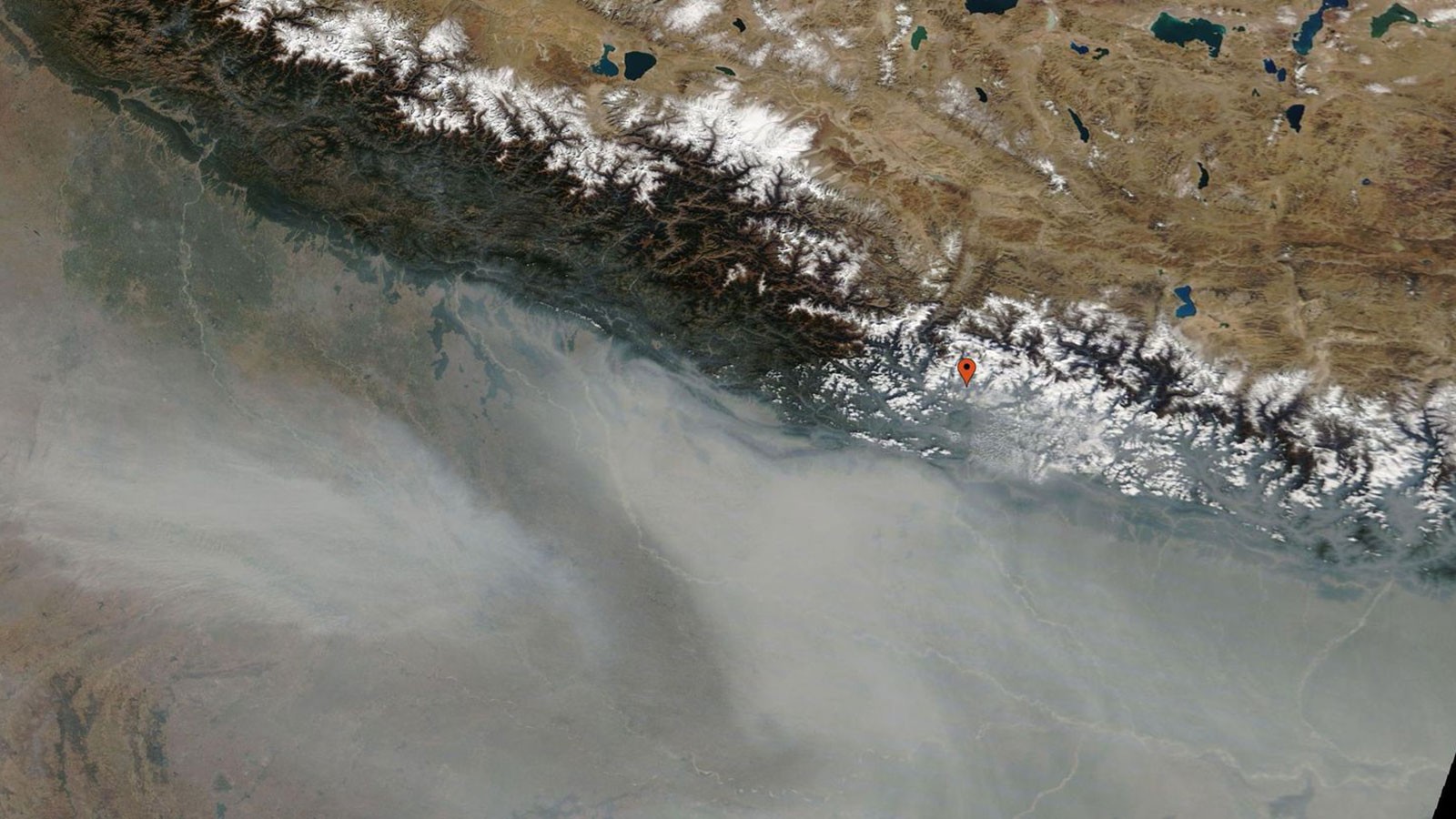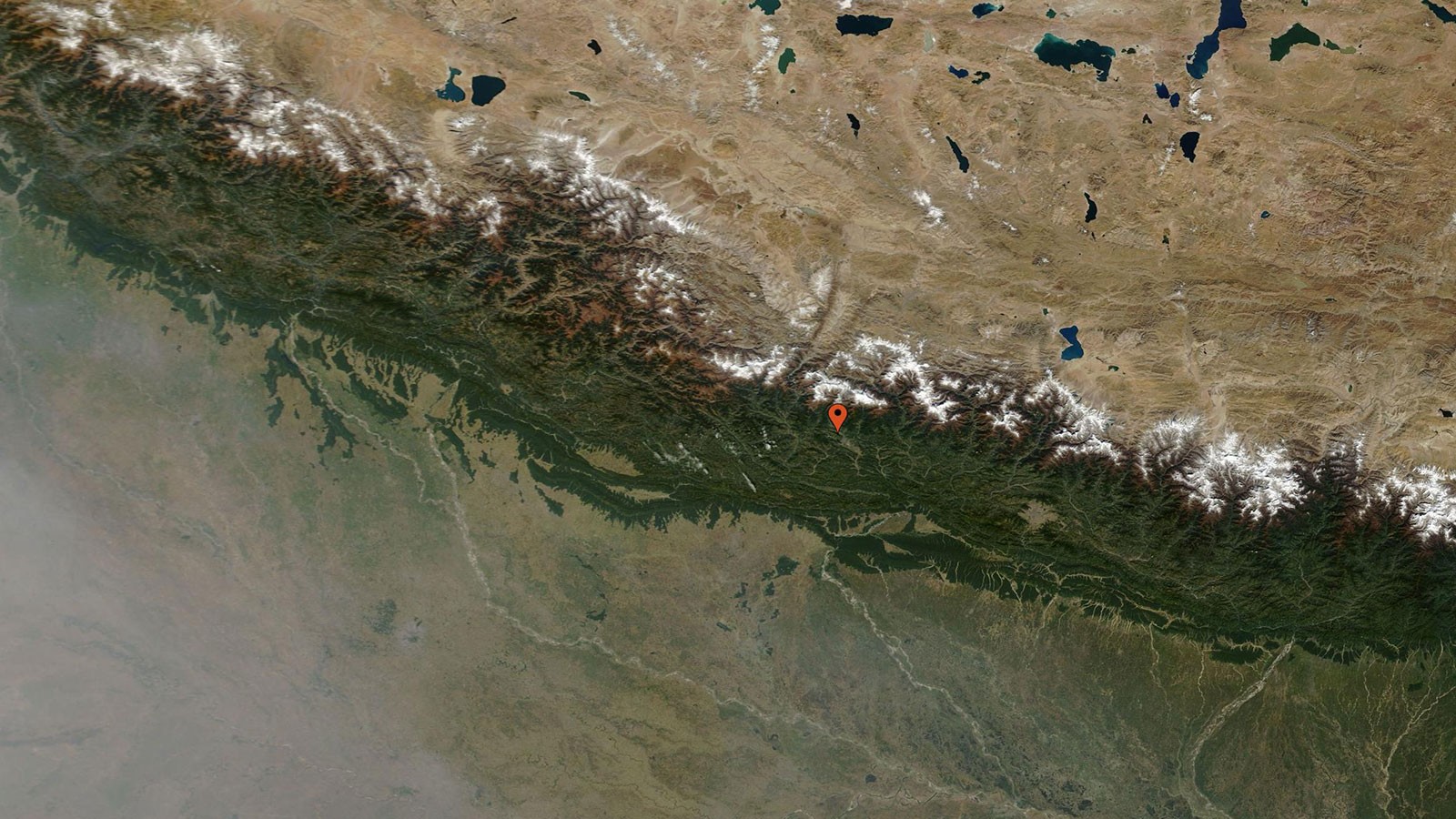Researchers Track Origins of Toxic Catastrophe in the Himalayas
By Lynnette Harris |
A satellite view of Nepal taken on Nov. 7, 2020, shows the severe pollution that researchers tracked to agricultural residue burning season in northern India. (NASA/worldview.earthdata.nasa.gov)
When a toxic blanket of polluted air settled over Kathmandu in November of 2020, the source of the pollution seemed obvious: In preparation for the wheat-growing season, farmers in the northern Indian states of Punjab and Haryana set their fields aflame to clear out the root-bound stems left over from the rice harvest, and prevailing winds often carry the resulting smoke hundreds of miles, contributing to highly polluted air in other countries.
Attributing any specific instance of pollution to its source with scientific certainty, however, had proven difficult. Now, using the 2020 event as a starting place, an international team of researchers has developed a method for tracking the origins of air pollution. The scientists hope their work, which has been published in the journal Atmospheric Pollution Research, may be a starting place for conversations and cooperation among affected countries.
"Before, there was not a good starting place for international discussions aimed at finding solutions,” said Sujan Khanal, a researcher in the Center for Analytical Sciences at the Kathmandu Institute of Applied Sciences and the paper's lead author. "Now, we hope, there is."
There are air pollution agreements that cover North America, Europe, Eurasia and Northeast Asia, said co-author Binod Pokharel, a climate scientist with a joint appointment at Utah State University and Tribhuvan University in Kathmandu.
“In these nations, cross-border pollution is dealt with through science-based cooperation to protect human health," Pokharel said. "But we don’t have anything like that across South Asia and the Indo-Gangetic Plain, even though this is a region where there is tremendous agricultural and industrial pollution.”
To understand the origins of the air pollution event in November of 2020, the researchers first needed to know if there were, in fact, active fires in Punjab and Haryana in the days before the toxic plume arrived. They answered that question with the use of several satellite-based sensors, including the Visible Infrared Imaging Radiometer Suite, which collects imagery of the land, atmosphere and oceans in both the visible and infrared bands of the electromagnetic spectrum. As suspected, they found ample evidence of field burning: More than 3,000 fires were burning at one time in the days before the pollution spike in Kathmandu.
Next, the researchers used a computer model that tracks air parcel trajectories. The model, known as the Hybrid Single-Particle Lagrangian Integrated Trajectory, was developed during the Cold War when the United States was seeking to ascertain the likely sources of air parcels to locate Soviet atomic testing sites. Today, the model is often used for wildland fire smoke forecasting.
“Using this back trajectory model, we could see quite clearly that the source of the air parcels at 500 and 1,000 meters had started around Punjab and Haryana,” said Rudra Prasad Pokhrel, a researcher at North Carolina A&T State University and the University of Colorado. “So, with that, we knew that there were fires, and that the air trajectories were set up in a way that it would be easy to carry the smoke from those fires into Nepal.”
One of the final pieces of the puzzle was the use of another satellite-based sensor, the Cloud-Aerosol Lidar and Infrared Pathfinder Satellite Observations, which uses the scattering patterns of light to distinguish the types of pollution in a given layer of atmosphere. Those measurements showed that the pollution that was being blown into the Kathmandu Valley in early November of 2020 was laden with the same kind of smoke that was emanating from the field-burning in Northern India.
“Some people say ‘where there is smoke, there is fire,’ but what we have done is connect the origins of smoke to a specific fire, and show the route by which it made its way to Nepal,” said Basant Giri, a researcher from the Center for Analytical Sciences at the Kathmandu Institute of Applied Sciences in Nepal. “Now the question is, ‘What can be done with this knowledge to improve the situation in the future?’”
Air pollution is a major driver of disease and death, and because air currents do not stop at national borders, polluting countries do not simply reap what they sow. In one study, published in the journal Nature in 2017, researchers estimated that about 12 percent of the 3.45 million premature deaths related to fine-particulate matter pollution were impacted by air pollutants emitted in a region of the world other than the one in which the deaths occurred.
Co-author Matthew LaPlante, an associate professor in the Department of Journalism and Communication and doctoral student in climate science at Utah State University, said the study isn't an attempt to "assign blame" for the problem. "What it does, however, is to take away plausible deniability," he said. "When you are trying to bring people together to communicate, accountability is a tremendous force multiplier."
Demonstrating that events like the pollution spike of late 2020 can be attributed to a specific source "might help drive further research, cooperation and political engagements across the region,” said Loknath Adhikari, a researcher at the Earth System Science Interdisciplinary Center at the University of Maryland. “And if that can result in even a small mitigation of air pollution, the result will be a healthier world for everyone.”
A satellite view of Nepal taken on Oct. 30, 2020, shows less air pollution than the Nov. 7 image. (NASA/worldview.earthdata.nasa.gov)
WRITER
Lynnette Harris
Marketing and Communications
College of Agriculture and Applied Sciences
435-764-6936
lynnette.harris@usu.edu
CONTACT
Matthew LaPlante
Faculty
Journalism and Communications Department
435-797-1353
matthew.laplante@usu.edu
ADDITIONAL RESOURCES
TOPICS
Environment 287stories Climate 161stories Satellites 69stories International 68stories Air Quality 57storiesComments and questions regarding this article may be directed to the contact person listed on this page.









